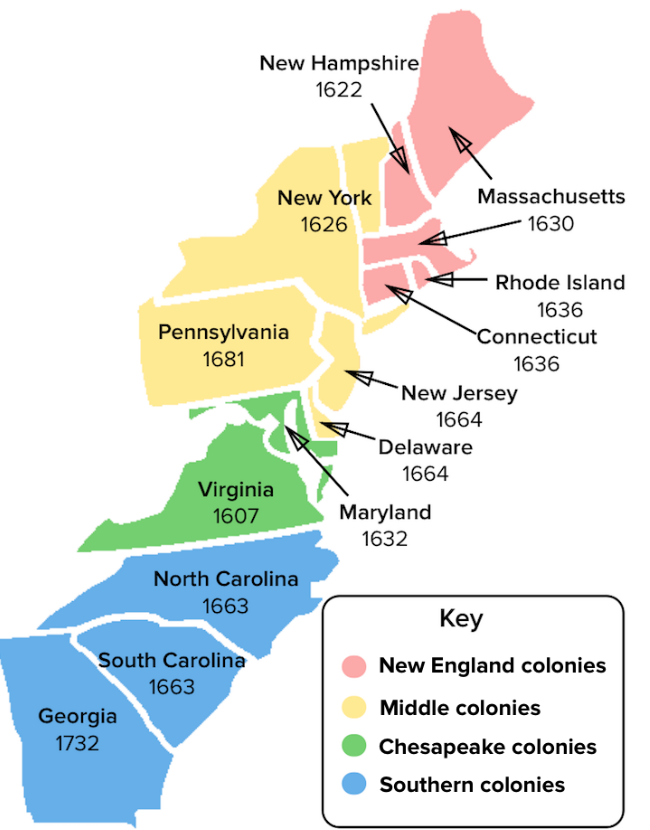
Early Colonial Experience


comparison of the three colonial regions !!
northern colonies:
economy based on skilled, artisan labor — woven pieces, metal tools, finished goods.
environment was rocky and cold. ideal for water powered mills, not farming.
colonists were heavily tied to the church + village communities
middle colonies:
good soil and moderate weather was ideal for farming — small to large farms.
coastal lowlands and many bays promoted naval shops and trading ports.
southern colonies:
great soil and longer growing season was ideal for cash crops — plantations arose.
less towns and cities, people were self sufficient.
wealthy aristocrats and slave labor — social and economic divide.
life was rugged and rural, promoting independence.
purpose | date | founder | export | |
virginia | commercial | 1607 | virginia company, john smith | tobacco |
plymouth / | religious refuge & commercial | 1620 / 1628 | william bradford, massachusetts bay company, john winthrop | grain, timber |
new york | commercial | 1613 (1664) | peter stuveysant (duke of york) | furs, grain |
new hampshire | commercial | 1623 | john mason | timber, naval stores |
rhode island | religious refuge | 1636 | roger williams | grain |
connecticut | expansion | 1635 | thomas hooker | grain |
pennsylvania | religious refuge | 1681 | william penn — quakers | grain |
delaware | commercial | 1638 (1681) | peter minuit / william penn | grain |
maryland | religious refuge | 1634 | lord baltimore - catholics | tobacco |
north carolina | commercial | 1663 | anthony cooper | tobacco, timber, naval stores |
south carolina | commercial | 1663 | anthony cooper | rice, indigo, naval stores |
georgia | buffer, experiment | 1733 | james oglethorpe | rice, timber, naval stores |
colonies lacked gold to trade, forcing them to barter with other items of value. therefore, they became a source of raw materials and a market for finished goods.
maximized exports, minimized imports
as the colonies grow more, the disparity between the rich and poor grows wider
rural areas displayed their wealth through land mass
urban areas displayed their wealth through their clothing and material possessions
luxury items (tea, linen, glassware) became necessities
Early Colonial Experience


comparison of the three colonial regions !!
northern colonies:
economy based on skilled, artisan labor — woven pieces, metal tools, finished goods.
environment was rocky and cold. ideal for water powered mills, not farming.
colonists were heavily tied to the church + village communities
middle colonies:
good soil and moderate weather was ideal for farming — small to large farms.
coastal lowlands and many bays promoted naval shops and trading ports.
southern colonies:
great soil and longer growing season was ideal for cash crops — plantations arose.
less towns and cities, people were self sufficient.
wealthy aristocrats and slave labor — social and economic divide.
life was rugged and rural, promoting independence.
purpose | date | founder | export | |
virginia | commercial | 1607 | virginia company, john smith | tobacco |
plymouth / | religious refuge & commercial | 1620 / 1628 | william bradford, massachusetts bay company, john winthrop | grain, timber |
new york | commercial | 1613 (1664) | peter stuveysant (duke of york) | furs, grain |
new hampshire | commercial | 1623 | john mason | timber, naval stores |
rhode island | religious refuge | 1636 | roger williams | grain |
connecticut | expansion | 1635 | thomas hooker | grain |
pennsylvania | religious refuge | 1681 | william penn — quakers | grain |
delaware | commercial | 1638 (1681) | peter minuit / william penn | grain |
maryland | religious refuge | 1634 | lord baltimore - catholics | tobacco |
north carolina | commercial | 1663 | anthony cooper | tobacco, timber, naval stores |
south carolina | commercial | 1663 | anthony cooper | rice, indigo, naval stores |
georgia | buffer, experiment | 1733 | james oglethorpe | rice, timber, naval stores |
colonies lacked gold to trade, forcing them to barter with other items of value. therefore, they became a source of raw materials and a market for finished goods.
maximized exports, minimized imports
as the colonies grow more, the disparity between the rich and poor grows wider
rural areas displayed their wealth through land mass
urban areas displayed their wealth through their clothing and material possessions
luxury items (tea, linen, glassware) became necessities
 Knowt
Knowt